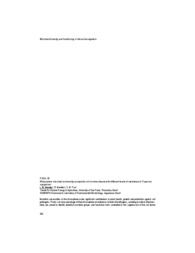Rhizosphere microbial community composition of common beans with different levels of resistance to Fusarium oxysporum.
Rhizosphere microbial community composition of common beans with different levels of resistance to Fusarium oxysporum.
Summary: Microbial communities in the rhizosphere make significant contributions to plant health, growth and protection against soil pathogens. Plants can take advantage of their rhizosphere microbiomes to fend off pathogens, avoiding microbial infections. Here, we aimed to identify potential microbial groups and functional traits correlated to the suppression of the soil borne Microbial diversity and functioning in the soil ecosystem 145 pathogen Fusarium oxysporum. Through shotgun metagenomics we investigated the rhizosphere microbial communities of four common bean cultivars with different levels of resistance to the fungus, ranging from susceptible to resistant. Plants were grown in mesocosms experiments with two contrasting soils, i.e. Amazon Dark Earth (ADE) and an agricultural soil (AS). The soils presented clear differences in chemical properties, and ADE hosts higher microbial diversity than AS. Chemical analysis indicated a significant increase of pH, Ca, Fe, sum of bases and base saturation, and decrease of K, Mg, exchangeable Al, and Mn in rhizosphere of both soil types. Quantitative PCR showed an increase of 16S rRNA copy number with the increase resistance to the fungus in ADE soil. The rhizosphere of the four bean cultivars is dominated by the same bacterial phyla Proteobacteria, Actinobacteria, Firmicutes, and Chloroflexi, albeit in different relative abundance between soil types. The community structure of rhizosphere was different from the bulk soil, revealing the selection process in this environment. In ADE soil, the most resistant cultivar presented higher taxonomic diversity when compared to other cultivars; in contrast, the functional diversity was lower. Comparing the resistant to the susceptible cultivars there was an increase of Nitrospirae, Solibacteres, Spirochaeta and Chryosiogenetes bacterial classes in the resistant. Also, resistant cultivar presented high number of sequences affiliated to the family Pseudomonadaceae and to the genera Bacillus and Solibacter. Interestingly, the resistant and moderately resistant cultivars, presented high proportion of sequences related to bacteriocin, a narrow spectrum antibiotic, which suggests its role on pathogen suppression. Preliminary analysis showed that the selection of the microbial communities inhabiting the common bean rhizosphere is cultivar and soil type dependent. Further analysis will search for bacterial groups potentially related to the fungal antagonism. FAPESP 2014/03217-3.
Publication year: 2015
Types of publication: Abstract in annals or event proceedings
Unit: Embrapa Environment
Keywords: Comunidade microbiana, Feijão, Fusarium Oxysporum, Rizosfera
Observation
Some of Embrapa's publications are published as ePub files. To read them, use or download one of the following free software options to your computer or mobile device. Android: Google Play Books; IOS: iBooks; Windows and Linux: Calibre.
Access other publications
Access the Agricultural Research Database (BDPA) to consult Embrapa's full library collection and records.
Visit Embrapa Bookstore to purchase books and other publications sold by Embrapa.

